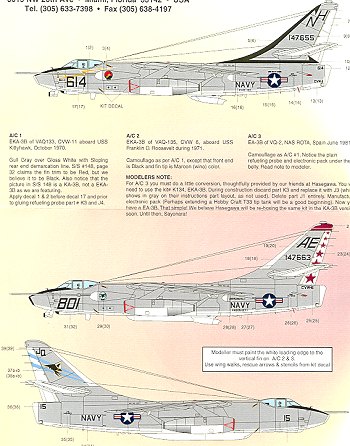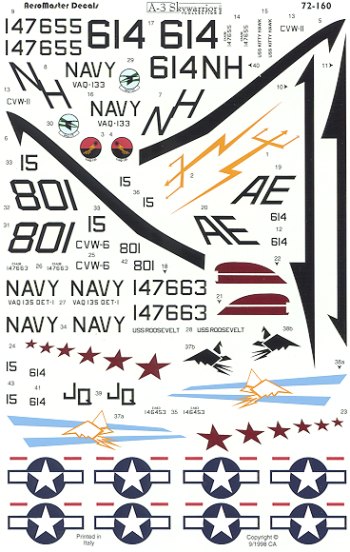|
Sheet # |
Aeromaster 72-160 |
|
Price: |
$8.00 |
|
Unit: |
See Review |
|
Review By: |
Scott Van Aken |
|
Notes: |
|
 It took nearly a year after the release of the
Hasegawa 1/72 A-3 Skywarrior for any decals to appear for it. Even then, it
seems as if we are limited to a total of four aftermarket sheets. Two from
Aeromaster and two from Superscale. Well, I guess it is better than none at all,
though some of the kit markings are duplicated in these four sheets.
It took nearly a year after the release of the
Hasegawa 1/72 A-3 Skywarrior for any decals to appear for it. Even then, it
seems as if we are limited to a total of four aftermarket sheets. Two from
Aeromaster and two from Superscale. Well, I guess it is better than none at all,
though some of the kit markings are duplicated in these four sheets.
This particular sheet offers
insignia enough to do two of the three subjects. It also gives advice on how to
modify a kit to do an EA-3B, but more on that when we get to it.
The first 'whale' is an
EKA-3B from VAQ-133 aboard the USS Kittyhawk in late 1970. This particular plane
can be build straight from the box as Hasegawa has released an EKA-3B version.
You will note that it has the side mounted antennas and these have white radomes.
Aeromaster has taken this scheme from Squadron/Signal's A-3 in Action
book. In that book is a picture of a KA-3B. This particular plane, as shown in
the drawing isn't really an EKA-3B as there is no ventral canoe. This canoe
carried steerable antennas and was part of the jamming package. I'd suggest some
more research before using this scheme.
Next is another EKA-3B, this
time from VAQ-135 on the FDR circa 1971. The tail markings on this plane were
later changed to the large bird that is part of the unit badge.
Finally, an EA-3B. This
is a VQ-2 bird. I'm sure it was chosen for the tail markings, but I would have
really preferred a VQ-1 plane. That now means that  no one makes decals for the two units in which
I maintained A-3s: VAQ-130 and VQ-1. If nothing else, it is exasperating. What
is really exasperating is that Aeromaster claims that making an EA-3B is simple.
They state that all you have to do is to remove an antenna or two and make a
ventral radome out of the wing tank of a Hobbycraft T-33.
no one makes decals for the two units in which
I maintained A-3s: VAQ-130 and VQ-1. If nothing else, it is exasperating. What
is really exasperating is that Aeromaster claims that making an EA-3B is simple.
They state that all you have to do is to remove an antenna or two and make a
ventral radome out of the wing tank of a Hobbycraft T-33.
Obviously they have not done
their research. The EA-3B had a sealed bomb bay and four operator positions in
that area. It had windows on the right side of the fuselage, similar to the
TA-3B. It also had a large reinforced door in the middle of that area so that
the crew could get in and out. Some operations were quite secret and involved
non-Naval systems operators. I can remember several involving Army personnel.
There was also an escape hatch in the roof of the plane in case the aircraft
ditched in the water and the normal entrance doors were not able to be used.
There were other differences in the airframe that made the EA and RA versions
different from the A, KA, and EKA versions. I'd recommend the Aerofax book on
the A-3 before making any attempt at doing a version not kitted by Hasegawa.
Review copy courtesy of me
and my wallet.
If you would like your product reviewed
fairly and quickly by a site that has over 2,000 visits a day, please contact me or see other details in the Note to Contributors.
 It took nearly a year after the release of the
Hasegawa 1/72 A-3 Skywarrior for any decals to appear for it. Even then, it
seems as if we are limited to a total of four aftermarket sheets. Two from
Aeromaster and two from Superscale. Well, I guess it is better than none at all,
though some of the kit markings are duplicated in these four sheets.
It took nearly a year after the release of the
Hasegawa 1/72 A-3 Skywarrior for any decals to appear for it. Even then, it
seems as if we are limited to a total of four aftermarket sheets. Two from
Aeromaster and two from Superscale. Well, I guess it is better than none at all,
though some of the kit markings are duplicated in these four sheets. no one makes decals for the two units in which
I maintained A-3s: VAQ-130 and VQ-1. If nothing else, it is exasperating. What
is really exasperating is that Aeromaster claims that making an EA-3B is simple.
They state that all you have to do is to remove an antenna or two and make a
ventral radome out of the wing tank of a Hobbycraft T-33.
no one makes decals for the two units in which
I maintained A-3s: VAQ-130 and VQ-1. If nothing else, it is exasperating. What
is really exasperating is that Aeromaster claims that making an EA-3B is simple.
They state that all you have to do is to remove an antenna or two and make a
ventral radome out of the wing tank of a Hobbycraft T-33.